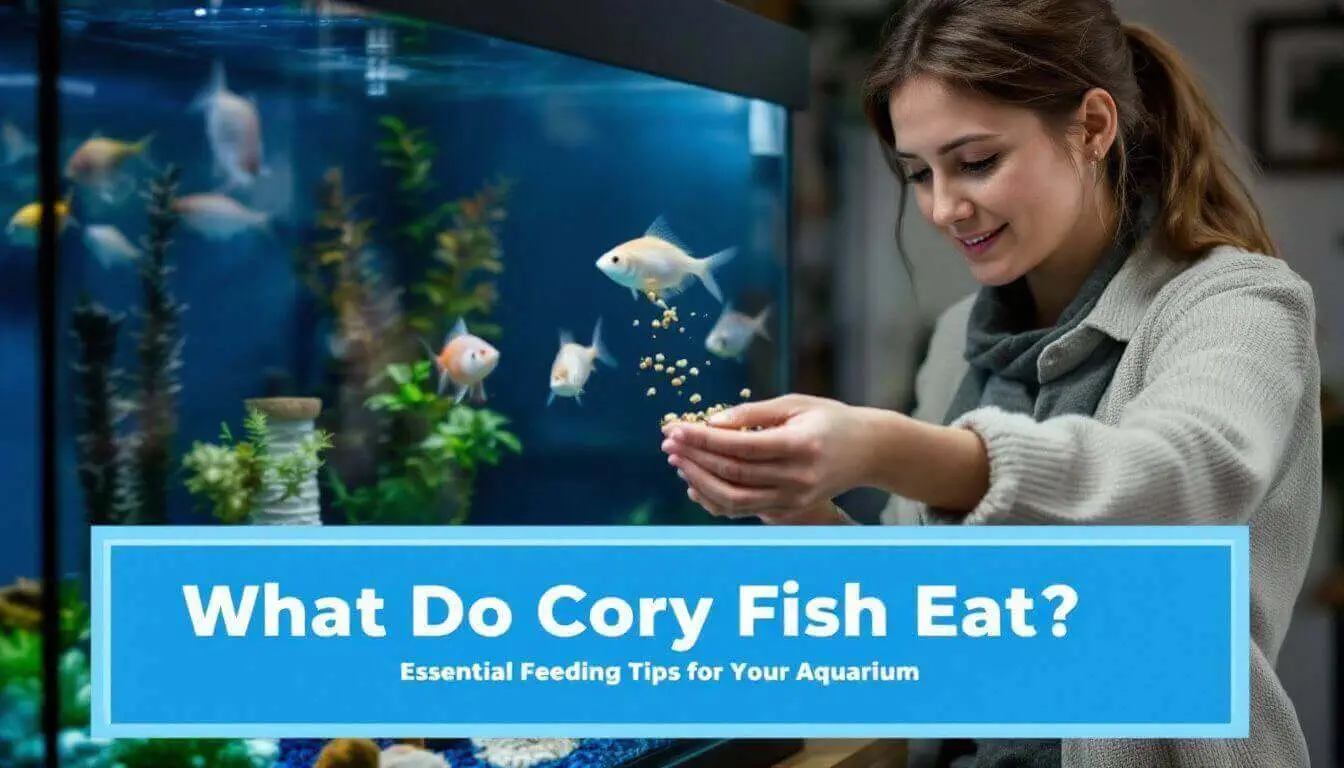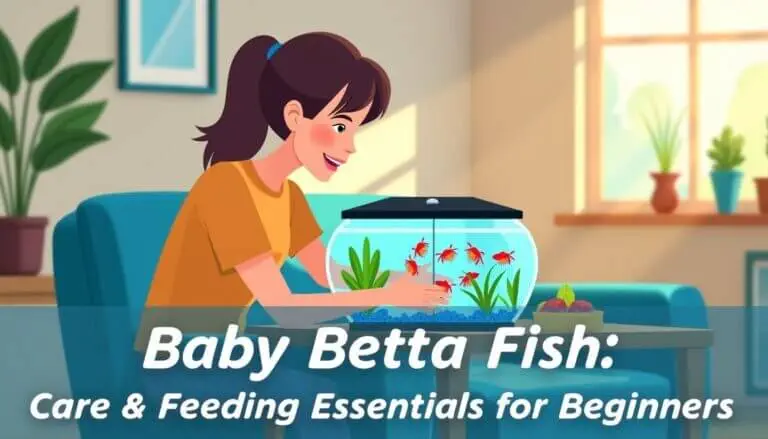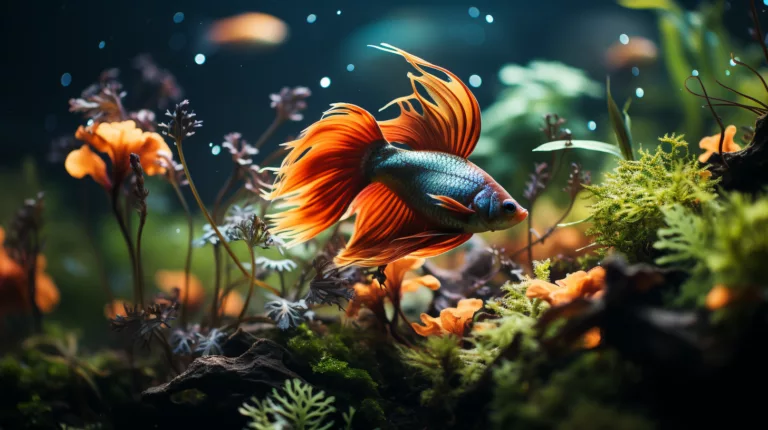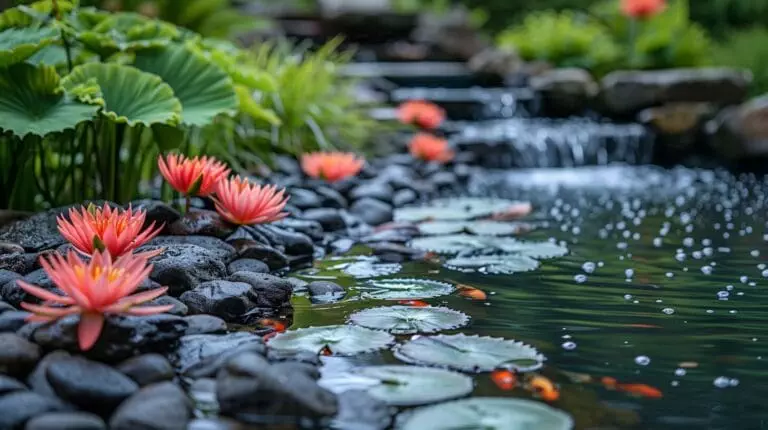Cory fish are great for your tank. But what do cory fish eat? Many people think these catfish only eat algae. That’s not true. Cory fish need a mix of foods to stay healthy. They like small pellets, flakes, and live foods. Feeding them right is key to their care. 1
I’ve kept cory fish for years. I’ve learned what works best for them. Cory fish are easy to feed once you know how. This guide will show you the best foods and tips for your cory fish. You’ll learn how to keep your fish happy and healthy. 3
Key Takeaways
- Cory fish eat a mix of foods like sinking pellets, flakes, frozen worms, and live treats.
- Feed cory catfish 2 to 3 times daily with small amounts they can eat in 2 to 3 minutes.
- Use a turkey baster to get food to the bottom of the tank where cories feed.
- Remove uneaten food after 10 to 15 minutes to keep the tank clean.
- Cory fish need water between 72°F and 82°F with a pH of 7.0 to 7.8 to stay healthy.
Understanding the Basics of Cory Catfish

Cory catfish are small, peaceful fish that thrive in groups. They come from South America and love to scavenge at the bottom of tanks.
What Are Cory Catfish and Their Natural Habitat?
Cory catfish belong to a diverse genus with over 160 species. These small, peaceful fish typically measure 1 to 3 inches long. Their natural habitats include streams, rivers, ponds, and marshy areas in South America. You’ll often find them in large groups, sometimes numbering in the hundreds. 1
These bottom dwellers thrive in specific water conditions. The ideal temperature range for most cory species is 72°F to 82°F. They prefer slightly acidic to neutral pH levels between 7.0 and 7.8. In your tank, mimic these conditions to keep your corys happy and healthy. 2
Corydoras are like tiny, armored janitors for your aquarium floor.
Next, let’s explore the lifespan and general care needs of these fascinating fish.
Lifespan and General Care of Corydoras
Corydoras catfish can live up to 5 years or more with proper care. 3 These hardy fish thrive in clean, well-maintained tanks. You’ll need at least a 20-gallon aquarium for most types.
Smaller species can do well in 10-gallon tanks. Feed your corys a mix of sinking pellets, frozen foods, and veggie wafers twice daily.
They love to dig, so use a soft sand substrate at least 2 inches deep. Group them in sixes or more of the same kind for best results. With good care, these peaceful bottom-dwellers will stay active and healthy for years.
The Importance of Temperature and Water Quality in an Aquarium
Cory catfish thrive in specific water conditions. They need a pH between 7.0 and 7.8. The best temperature is 72°F to 78°F. Clean water is crucial for their health. Poor water can stress them out and make them sick.
A 20-gallon tank works well for most cory species. It helps keep the water clean and stable. Wild-caught corys prefer softer water with a pH of 5.5 to 7.0. 1
Good water quality affects more than just health. It can trigger breeding in corys. 1 Changes in water conditions often spark spawning behavior. Keeping the right balance is key for happy, active fish. Next, let’s look at what cory fish like to eat.
What Do Cory Fish Eat? Feeding Habits Explained

Cory fish love a mix of foods. They munch on flakes, pellets, and live treats like worms.
Common Foods for Corydoras in an Aquarium
Cory catfish need a varied diet to stay healthy. You can feed them many tasty foods in your tank.
- Sinking wafers: These pellets sink to the bottom where cories feed.
- Frozen bloodworms: A meaty treat cories love to eat.
- Live blackworms: Another worm cories enjoy hunting for.
- Hikari Vibra Bites: Small, soft food that mimics worms.
- Repashy gel foods: A mix of nutrients in an easy-to-eat form.
- Small crustaceans: Daphnia and brine shrimp make good snacks.
- Soft vegetables: Blanched zucchini or cucumber slices work well.
- Catfish pellets: Made just for bottom-feeding fish like cories.
- Frozen brine shrimp: A protein-rich food cories can easily eat.
- Algae wafers: While not their main food, these add variety.
Now let’s look at how to feed your cory catfish the right way.
How to Properly Feed My Cory Catfish
Now that you know what Corydoras eat, let’s focus on how to feed them properly. Feeding your Cory catfish the right way ensures they stay healthy and active in your tank.
- Use a turkey baster: Squirt shrimp pellets directly to your Cory fish. This method helps get food to the bottom where they like to eat.
- Watch individual fish: Some Corys may not eat leftovers. Make sure each fish gets enough food.
- Feed in groups: Cories prefer to eat together. Put food in one spot so they can gather.
- Night feeding: Try feeding after lights out. This cuts down on other fish stealing their food.
- Offer variety: Give small, soft foods. Mix up their diet with different treats.
- Feed Corydoras directly: Don’t rely on scraps from other fish. Give them their own meals.
- Monitor eating habits: Keep an eye on how much and how often your Corys eat. Adjust as needed.
- Use sinking foods: Pick foods that fall to the tank bottom. This matches their natural feeding style.
- Break up larger pieces: Crush big flakes or pellets. This makes it easier for Corys to eat.
- Clean up leftovers: Remove uneaten food after 10 to 15 minutes. This keeps your tank clean.
Special Diet Needs for Breeding Cory Catfish
Breeding cory catfish requires a special diet. Feed them live blackworms and frozen bloodworms to boost their health. 5 Cool the water slightly and give them nutritious foods to encourage spawning. 5
After breeding, you’ll see sticky eggs on tank walls and decor. To help baby catfish survive, add dense cover and remove other fish. Feed the fry live baby brine shrimp and powdered food made for young fish .
Best Feeding Practices for Cory Catfish in a Tank

Cory catfish thrive on a mix of sinking pellets, flakes, and live treats. Want to learn more about keeping your bottom-dwellers happy and healthy? Read on!
Choosing the Right Food for Cory Fish Diet
Cory fish need a balanced diet to stay healthy. You can choose from many food options for your cory catfish.
- Live blackworms: These worms are a top choice for cory fish. They’re packed with nutrients and mimic natural prey.
- Frozen bloodworms: A tasty treat that cory fish love. Thaw them before feeding to avoid digestive issues.
- Hikari Vibra Bites: These pellets look like worms and sink to the bottom. They’re perfect for bottom-feeding cory fish.
- Repashy gel foods: Easy to make and nutritious. You can cut them into small pieces for your cory fish.
- Sinking wafers: These are made for bottom-feeders like cory fish. They don’t float, so your fish can easily find them.
- Insect-based foods: Look for foods with insects as the main ingredient. They match what cory fish eat in nature.
- Worm-based foods: Foods with worms as the main ingredient are great for cory fish. They’re high in protein.
- Fish-based foods: These foods are also good for cory fish. They provide essential nutrients.
- Avoid grain-heavy foods: Don’t pick foods with soy, wheat, or grains as the main ingredients. They’re not natural for cory fish.
- Algae wafers: Use these as treats, not main meals. They add variety to your cory fish diet.
Ideal Feed Types for Different Tank Conditions
Tank conditions affect what Cory catfish eat. Here are ideal feed types for different setups:
- Community tanks: Sinking wafers and pellets work well. These foods reach the bottom where Corys feed.
- Species-only tanks: Offer a mix of live and frozen foods. Blackworms and bloodworms are favorites.
- Planted aquariums: Use sinking foods that won’t harm plants. Repashy gel foods stick to surfaces without fouling water.
- Breeding tanks: Feed high-protein foods like live baby brine shrimp. This helps stimulate spawning.
- Fry tanks: Provide powdered fry food and newly hatched brine shrimp. These tiny foods suit baby Corys.
- Cold water setups: Choose foods that break down slowly. Hikari Vibra Bites last longer in cooler temps.
- Warm water tanks: Offer foods more often. Corys have faster metabolisms in warmer water.
- Bare-bottom tanks: Use sinking wafers that don’t break apart easily. This keeps the tank cleaner.
How to Observe Feeding Behavior in Your Cory Catfish
Cory catfish have unique feeding habits. Watch them closely to ensure they’re eating well.
- Use a turkey baster to feed pellets directly to your cories
- Look for cories actively searching the bottom for food
- Check if shrimp pellets sink into the substrate
- Notice if different types of cories eat at different times
- Scan for leftover food bits after feeding time
- Observe if cories feed together in groups
- Watch for increased feeding after lights go out
- See if cories ignore certain foods you offer
- Look for barbels moving as they search for food
- Note how often your cories come up for air
- Watch for cories digging in the substrate for food
Proper feeding keeps your cory catfish healthy and active. Next, we’ll cover common issues related to cory fish feeding.
Common Issues Related to Cory Fish Feeding

Feeding issues can spell trouble for your cory fish. Watch out for signs of poor diet and learn how to fix them fast.
Recognizing Symptoms of Improper Diet in Corydoras
Cory catfish need a balanced diet to stay healthy. Look for these signs of poor nutrition in your corydoras:
- Lack of energy: Your cory may swim less or rest more often.
- Color changes: Fading or dull colors can signal diet issues.
- Weight loss: A thin or bony appearance means your fish isn’t getting enough food.
- Slow growth: Young corys should grow steadily. Stunted growth points to diet problems.
- Curved spine: A bent or twisted spine can result from vitamin deficiencies.
- Sunken belly: This shows your cory isn’t eating enough.
- Stringy poop: Unusual waste can mean digestive troubles from a poor diet.
- Refusal to eat: Corys may ignore food they don’t like or can’t digest well.
- Fin damage: Torn or ragged fins might come from lack of nutrients.
- Gasping at surface: This could mean your cory lacks energy from poor nutrition.
Ways to Prevent Disease Through Proper Feeding
Proper feeding keeps your cory catfish healthy and disease-free. Follow these tips to prevent illness in your aquatic friends:
- Feed a varied diet. Mix flakes, pellets, and live foods for balanced nutrition.
- Don’t overfeed. Give small amounts 2 to 3 times daily that fish can eat in 2 to 3 minutes.
- Remove uneaten food. Scoop out leftovers after 10 to 15 minutes to keep water clean.
- Use a feeding dish. This keeps food in one spot and makes cleanup easier.
- Offer sinking foods. Cory catfish are bottom feeders and need food that reaches them.
- Thaw frozen foods. Never feed still-frozen items, as this can harm fish digestive systems.
- Rinse live foods. This removes parasites or harmful bacteria before feeding.
- Avoid human food. Table scraps can upset fish stomachs and dirty the water.
- Feed at set times. A regular schedule helps fish digest properly.
- Watch for changes. Adjust food amounts if fish seem hungry or leave food uneaten.
Addressing Nutritional Deficiencies in Cory Fish
Cory fish need a mix of foods to stay healthy. You’ll spot signs of poor diet in dull colors or slow growth. Fix this by giving them varied meals. Offer algae wafers, sinking pellets, and frozen foods.
Mix in some veggies too. Keep an eye on how much they eat. Adjust amounts if needed. A good diet keeps your cory fish active and bright.
Next, let’s look at how to keep your whole tank healthy with the right feeding habits.
Ensuring a Healthy Diet for Your Cory Fish

Cory fish need a mix of foods to stay healthy. Give them sinking pellets, frozen foods, and veggies to keep them happy and active.
Maintaining a Balance in Your Community Tank
Keep your community tank balanced by choosing fish that get along with Corydoras. Put at least six Corydoras together to keep them happy. They like peaceful tank mates who won’t bother them. 1 Make sure the water stays between 72°F and 82°F for all your fish to thrive.
Feed your Corydoras a mix of protein-rich foods. Give them small, soft items and sinking wafers. Don’t overfeed – it can mess up your water quality. Use top-notch fish food to keep everyone healthy. This way, your Corydoras and other fish will live well together in your tank.
Future Trends in Aquarist Feeding Practices for Corydoras
Balanced community tanks set the stage for new feeding trends. Aquarists now focus on high-protein diets for Corydoras. Fluval Bug Bites lead this shift with Black Soldier Fly larvae as a key ingredient.
These foods pack more nutrients in each bite. You’ll see more sustainable options hitting the market soon. Specialized foods for Corydoras will grow in popularity. These cater to their unique needs as bottom feeders.
Expect to find foods that mimic their natural diet more closely. This includes small crustaceans and plant matter. Future feeds will likely boost fish health and color even more. 6
Conclusion
Cory fish need a varied diet for good health. Feed them sinking pellets, flakes, and frozen foods. Watch your fish eat to ensure they get enough. Clean uneaten food to keep the tank fresh.
Your cory catfish will thrive with proper care and the right food.
FAQs
1. What do cory catfish like to eat?
Cory catfish enjoy a mix of foods. They eat flakes, pellets, and wafers. These fish also like live foods such as brine shrimp and bloodworms. They’re not picky eaters!
2. How often should I feed my cory catfish?
Feed your cory catfish twice a day. Give them small amounts they can eat in 2-3 minutes. Don’t overfeed – it’s bad for the water.
3. Can cory catfish eat with other fish?
Yes! Cory catfish are peaceful bottom dwellers. They get along with many fish like tetras. But watch out for big, mean fish that might hurt them.
4. Do different types of cory catfish eat the same things?
Most cory types eat alike. Peppered cory, julii cory, and panda cory all like similar foods. The pygmy cory – the smallest kind – may need smaller bits.
5. Where should I put food for my cory catfish?
Put food at the bottom of the tank. Cory fish have downward-facing mouths. They search for food on the floor. Some sinking pellets or wafers work great.
6. Are there foods cory catfish shouldn’t eat?
Avoid foods with lots of fillers. Don’t use stuff meant for ponds. Skip foods with copper – it’s bad for them. Always check if a food is safe before you feed it.
References
- ^ https://www.aqueon.com/resources/care-guides/corydoras-catfish
- ^ https://www.webmd.com/pets/what-are-cory-catfish
- ^ https://www.aquariumcarebasics.com/freshwater-aquarium-fish/cory-catfish/
- ^ https://en.aqua-fish.net/articles/corydoras-catfish-detailed-guide-forum (2024-08-29)
- ^ https://www.aquariumcoop.com/blogs/aquarium/cory-catfish-care-guide?srsltid=AfmBOopzQUQuMEXocCwXflb5fdrXKcB2_1aW-R20cUcbT1f7zXdnHZZ-
- ^ https://aquariumsforbeginners.com/blogs/guides/what-to-feed-your-cory-catfish (2024-06-13)





